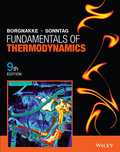
The relation between the reversible and irreversible QL
Answer to Problem 5.1P
Explanation of Solution
Given information:
Two engines receive the same heat transfer in (QH). One engine is reversible and other engine is irreversible.
Concept used:
The efficiency of reversible heat engine is more than the efficiency of irreversible heat engine.
Here, W is the work done, QH is the heat transfer in and QL is the heat transfer out.
Calculation:
We know that,
Two engines have same QH, thus
Conclusion:
The heat transfer out in reversible engine is less than the heat transfer out in irreversible engine.
Want to see more full solutions like this?
Chapter 5 Solutions
EBK FUNDAMENTALS OF THERMODYNAMICS, ENH
- For a heat engine, if QH = 600.00 kJ, and QL = 350.00 kJ, then thermal efficiency is _____________%arrow_forwardA heat engine, a heat pump, and a refrigerator receive 500 kJ of heat each. But they reject 250 kJ, 600 kJ and 700 kJ of heat respectively. Determine the efficiency of heat engine, the COP of the heat pump and the refrigerator.arrow_forwardWhat is the efficiency of a Diesel Engine if the heat added is 19 BTU and heat rejected is 9 BTU?arrow_forward
- Two reversible cycles are in series, each process doing the same net work, Wcycle. The first cycle receives energy QH by heat transfer from a hot reservoir at 1000°R and energy Q is reinjected by heat transfer to a reservoir at an intermediate temperature, T. The second cycle receives energy Q by heat transfer from the reservoir at temperature T and reinjects the QC energy by heat transfer to the reservoir at a temperature of 400°R. All energy transferred is positive in the direction of the arrow. Determine: a) the intermediate temperature T, in °R, and the thermal efficiency for each of the two cycles; b) the thermal efficiency of a simple reversible cycle operating between the hot and cold reservoirs at 1000°R and 400°C, respectively. Then determine the net work done by the simple cycle, expressed in terms of the net work done by each of the two cycles, Wcycle.arrow_forwardThe maximum thermal efficiency possible for a power cycle operating between 1200 F and 225 F isarrow_forwardConsider the re-heat regenerative cycle as shown in the figure below:Suppose that the boiler operates at a constant pressure of 15MPa. The High Pressure turbine expands steam until 4MPa. The Low-pressure turbine then achieves expansion to 700 kPa and 20 kPa. Determine the specific work of Pump II in kJ/kg. a.3.66 b.0.69 c.15.23 d.15.84arrow_forward
- A heat pump is used to heat a house. The heat loss of the house at a time when the outside temperature is A ° C is B kJ / h. The interior temperature of the house is C ° C. If the coefficient of action (COPIP) of the heat pumpis D under these conditions ,a) The power consumed by the heat pump [kW],b) The heat transferred from the cold outside air to the heat pump [kJ / h]c) If the heat pump is considered to work reversibly,calculate the COPIP.arrow_forwardAn AC with a heat transfer rate of 55000 BTU/HR from air @14.7 psia and 95 degrees F, with rate of 1500 ft3/min. Refrigerant 134a is used and evaporates at a constant pressure of 50 psia from compressed liquid conditions, 30F, to exit temperature of 50 F. For air, Cp=0.24 Btu/lbm-R and Rair=53.3 ft-lbf/lbm-R; Determine the mass-flow-rate of liquid refrigerant required and the exit temperature of the air. Sorry for the missing infoarrow_forwardA heat engine has a total heat input of 1.3 kJ and a thermal efficiency of 35 percent. How much work will it produce?arrow_forward
- Two reversible engines R1 and R2 are connected ins series between a heat source S and a cold body C. If T1 = 1200 R, T2 = 450 R, QH = 400 BTU and the engines have equal thermal efficiencies Determine the following a.) The temperature at which heat is rejected by R1 and received by R2 b.) The heat rejected to the cold bodyarrow_forwardAs shown in the figure below, a reversible power cycle receives energy QH by heat transfer from a hot reservoir at TH and rejects energy QC by heat transfer to a cold reservoir at TC. (a) If TH = 1600 K and TC = 400 K, what is the thermal efficiency?(b) If TH = 500°C, TC = 20°C, and Wcycle = 1000 kJ, what are QH and QC, each in kJ?(c) If η = 70% and TC = 40°F, what is TH, in °F?(d) If η = 40% and TH = 1027°C, what is TC, in °C?arrow_forward2. A power cycle receives energy QH by heat transfer from a hot reservoir at TH = 1200 R and rejects energy QC by heat transfer to a cold reservoir at TC = 400 R. For each of the following cases, determine whether the cycle operates reversibly, operates irreversibly, or is impossible. (a) QH = 900 Btu, Wcycle = 450 Btu (b) QH = 900 Btu, QC = 300 Btu (c) Wcycle = 600 Btu, QC = 400 Btu (d) Eff. = 70%arrow_forward
 Elements Of ElectromagneticsMechanical EngineeringISBN:9780190698614Author:Sadiku, Matthew N. O.Publisher:Oxford University Press
Elements Of ElectromagneticsMechanical EngineeringISBN:9780190698614Author:Sadiku, Matthew N. O.Publisher:Oxford University Press Mechanics of Materials (10th Edition)Mechanical EngineeringISBN:9780134319650Author:Russell C. HibbelerPublisher:PEARSON
Mechanics of Materials (10th Edition)Mechanical EngineeringISBN:9780134319650Author:Russell C. HibbelerPublisher:PEARSON Thermodynamics: An Engineering ApproachMechanical EngineeringISBN:9781259822674Author:Yunus A. Cengel Dr., Michael A. BolesPublisher:McGraw-Hill Education
Thermodynamics: An Engineering ApproachMechanical EngineeringISBN:9781259822674Author:Yunus A. Cengel Dr., Michael A. BolesPublisher:McGraw-Hill Education Control Systems EngineeringMechanical EngineeringISBN:9781118170519Author:Norman S. NisePublisher:WILEY
Control Systems EngineeringMechanical EngineeringISBN:9781118170519Author:Norman S. NisePublisher:WILEY Mechanics of Materials (MindTap Course List)Mechanical EngineeringISBN:9781337093347Author:Barry J. Goodno, James M. GerePublisher:Cengage Learning
Mechanics of Materials (MindTap Course List)Mechanical EngineeringISBN:9781337093347Author:Barry J. Goodno, James M. GerePublisher:Cengage Learning Engineering Mechanics: StaticsMechanical EngineeringISBN:9781118807330Author:James L. Meriam, L. G. Kraige, J. N. BoltonPublisher:WILEY
Engineering Mechanics: StaticsMechanical EngineeringISBN:9781118807330Author:James L. Meriam, L. G. Kraige, J. N. BoltonPublisher:WILEY





